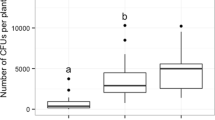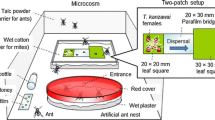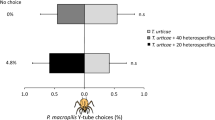Abstract
Interactions within the natural enemy complex of plant-inhabiting mites are of practical interest. There are frequently several predatory mite species present or available for introduction and it is difficult to tell whether a single species or combination of species should provide the most effective means of biological control. We used a simulation model to examine the interactions between predatory mites of two families, the Stigmaeidae and Phytoseiidae, representatives of which feed on phytophagous apple mites. To identify key differences in predatory behavior and life history, various stigmaeid parameters were substituted with those of phytoseiids, and changes in the efficacy of either stigmaeids alone or in combination with phytoseiids were evaluated graphically. At low prey densities stigmaeids held an advantage over phytoseiids in terms of efficacy because of their higher preference for prey eggs, higher oviposition relative to prey consumption and the ability to consume their own eggs, while at high prey densities the higher maximum predation rate of phytoseiids gave them a higher efficacy. Thus the weaker predator (the stigmaeid) is the more effective competitor at low prey densities. The model did not account for dispersal, but since stigmaeids are the weaker dispersers, the possibility of developing stability in this system is much greater than if phytoseiids were the better competitors. A combination of stigmaeids and phytoseiids was shown to have greater efficacy than either predator alone over a wide range of prey densities.
Similar content being viewed by others
References
Amano, H. and Chant, D.A., 1978. Some factors affecting reproduction and sex ratios in two species of predacious mites,Phytoseiulus persimilis Athias-Henriot andAmblyseius andersoni (Chant) (Acarina: Phytoseiidae). Can. J. Zool., 55: 1978–1983.
Amano, H. and Chant, D.A., 1990. Species diversity and seasonal dynamics of Acari on abandoned apple trees in Southern Ontario, Canada. Exp. Appl. Acarol., 8: 71–96.
Berkett, L.P. and Forsythe, H.Y., Jr., 1980. Predaceous mites (Acari) associated with apple foliage in Maine. Can. Entomol., 112: 497–502.
Castagnoli, M. and Nannelli, R., 1987. Further observations on population trends of mites in a peach orchard-meadow in central Italy. Redia, 70: 121–134.
Clements, D.R. and Harmsen, R., 1990. Predatory behavior and prey-stage preferences of stigmaeid and phytoseiid mites and their potential compatibility in biological control., Can. Entomol., 122: 321–328.
Clements, D.R., Harmsen, R. and Clements, P.J., 1991. A mechanistic simulation to complement an empirical transition matrix model of acarine population dynamics. Ecol. Modelling, 59: 257–277.
Croft, B.A. and McGroarty, D.L., 1977. The role ofAmblyseius fallacis (Acarina: Phytoseiidae) in Michigan apple orchards. Mich. State Univ. Agric. Exp. Stn. Res. Rep., 333, 22 pp.
Croft, B.A., MacRae, I.V. and Currans, K.G., 1992. Factors affecting biological control of apple mites by mixed populations ofMetaseiulus occidentalis andTyplodromus pyri. Exp. Appl., Acarol., 14: 343–355.
Dicke, M., Sabelis, M.W., de Jong, M. and Alers, M.P.T., 1988. Analysis of prey preference in phytoseiid mites by using an olfactometer, predation models and electrophoresis. Exp. Appl. Acarol., 5: 225–241.
Dicke, M., Sabelis, M.W., de Jong, M. and Alers, M.P.T., 1990. Do phytoseiid mites select the best prey species in terms of reproductive success? Exp. Appl. Acarol., 8: 161–173.
Dover, J.J., Croft, B.A., Welch, D.M. and Tummala, R.L., 1979. Biological control ofPanonychus ulmi (Acarina: Tetranychidae) byAmblyseius fallacis (Acarina: Phytoseiidae) on apple: a prey-predator model. Environ. Entomol., 8: 282–292.
Dunley, J.E. and Croft, B.A., 1990. Dispersal between and colonization of apple byMetaseiulus occidentalis andTyphlodromus pyri (Acarina: Phytoseiidae). Exp. Appl. Acarol., 10: 137–149.
Hassell, M.P. and May, R.M., 1986. Generalist and specialist natural enemies in insect predatory-prey interactions. J. Anim. Ecol., 55: 923–940.
Herbert, H.J. and Butler, K.P., 1973. Distribution of phytophagous and predacious mites on apple trees in Nova Scotia. Can. Entomol., 105: 271–276.
Holdsworth, R.P., Jr., 1972.Zetzellia mali andAgistemus fleschneri: Difference in spatial distribution. Environ. Entomol., 1: 532–533.
Hoyt, S. C., 1969. Population studies of five mite species on apple trees in Washington. In: G.O. Evans (Editor), Proc. 2nd Int. Cong. Acarol., Akadémiai Kiadó, Budapest, pp. 117–133.
Kakehashi, M., Suzuki, Y. and Iwasa, Y., 1984. Niche overlap of parasitoids in host-parasitoid systems: Its consequence to single versus multipole introduction controversy in biological control. J. Appl. Ecol., 21: 115–131.
McMurtry, J.A., Johnson, H.G. and Ball, M.H., 1984. Experiments to determine effects of predator releases on populations ofOligonychus punicae (Acarina: Tetranychidae) on avocado in California. Entomophaga, 29: 11–19.
Royama, T., 1971. A comparative study of models for predation and parasitism. Res. Popul. Ecol. Suppl., 1: 1–91.
Sabelis, M.W., 1985. Predation on spider mites. In: W. Helle and M.W. Sabelis (Editors), Spider Mites: Their Biology, Natural Enemies and Control, Vol. 1B. Elsevier, Amsterdam, pp. 103–129.
Santos, M.A., 1976. Evaluation ofZetzellia mali as a predator ofPanonychus ulmi andAculus schlechtendali. Environ. Entomol., 5: 187–191.
Santos, M.A., 1984. Effects of host plant on the predator-prey cycle ofZetzellia mali (Acari: Stigmaeidae) and its prey. Environ. Entomol., 13: 65–69.
Santos, M.A., 1991. Searching behavior and associational response ofZetzellia mali (Acarina: Stigmaeidae). Exp. Appl. Acarol., 11: 81–87.
Santos, M.A. and J.E. Laing, 1985. Stigmaeid predators. In: W. Helle and M.W. Sabelis (Editors), Spider Mites: Their Biology, Natural Enemies and Control. Vol. 1B. Elsevier, Amsterdam, pp. 197–203.
Strapazzon, A. and Dalla Monta, L., 1988. Role and distribution ofAmblyseius andersoni Chant andZetzellia mali Ewing in apple orchards infested byAculus schlechtendali Nalepa. Redia, 71: 39–54.
Strickler, N.N., Cushing, M., Whalon, M.E. and Croft, B.A., 1987. Mite (Acari) species composition in Michigan apple orchards. Environ. Entomol., 17: 30–36.
Takafuji, A. and Chant, D.A., 1976. Comparative studies of two species of predacious phytoseiid mites (Acarina: Phytoseiidae), with special reference to their response to the density of their prey. Res. Popul. Ecol., 10: 54–68.
Turnbull, A.L. and Chant, D.A., 1961. The practice and theory of biological control of insects in Canada. Can. J. Zool., 39: 697–753.
Waage, J.K. and Hassell, M.P., 1982. Parasitoids as biological control agents—A fundamental approach. Parasitology 84: 241–268.
White, N.D.G. and Laing, J.E., 1977a. Some aspects of the biology and a laboratory life table of the acarine predatorZetzellia mali. Can. Entomol., 109: 1275–1281.
White, N.D.G. and Laing, J.E., 1977b. Field observations ofZetzellia mali (Ewing) (Acarina: Stigmaeidae) in southern Ontario apple orchards. Proc. Entomol. Soc. Ont., 108: 23–30.
Woolhouse, M.E.J. and Harmsen, R., 1987a. A transition matrix model of seasonal changes in mite populations. Ecol. Modelling, 37: 167–189.
Woolhouse, M.E.J. and Harmsen, R., 1987b. A transition matrix model of the population dynamics of a two-prey-two-predator acarid complex. Ecol. Modelling, 39: 307–323.
Yao, D.S. and Chant, D.A., 1989. Population growth and predation interference between two species of predatory phytoseiid mites (Carina: Phytoseiidae) in interactive systems. Oecologia, 80: 443–455.
Yao, D.S. and Chant, D.A., 1990. Changes in body weight of two species of predatory mites (Acarina: Phytoseiidae) as a consequence of feeding in an interactive system. Exp. Appl. Acarol., 8: 195–220.
Author information
Authors and Affiliations
Rights and permissions
About this article
Cite this article
Clements, D.R., Harmsen, R. Stigmaeid-phytoseiid interactions and the impact of natural enemy complexes on plant-inhabiting mites. Exp Appl Acarol 14, 327–341 (1992). https://doi.org/10.1007/BF01200571
Issue Date:
DOI: https://doi.org/10.1007/BF01200571




